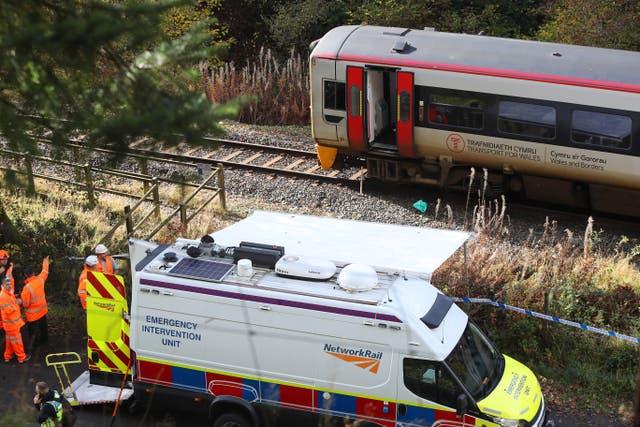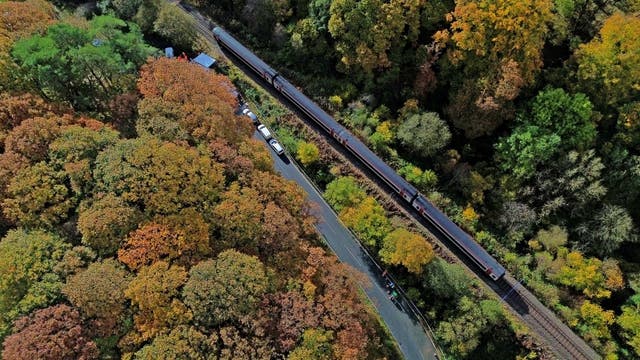An automated system that helps train wheels grip tracks failed on a train involved in a fatal crash in mid-Wales on October 21, investigators said.
Hoses fitted to the Transport for Wales (TfW) train to discharge sand when wheels slide during braking were “blocked”, the Rail Accident Investigation Branch (RAIB) said in an update on its inquiry.
TfW and Network Rail said it is “fundamental that we await the findings of the full report”.
The train with the failed safety system was travelling at between 15mph and 24mph when it collided head-on with another TfW train travelling at around 6mph.
We’ve updated our announcement https://t.co/sRdlE28hpx following the collision between two passenger trains near Talerddig, Powys, on 21 October 2024 to explain more about the accident and the aims of our investigation. Find out more at raib/gov.uk
#Talerddig #Powys #Wales pic.twitter.com/9aHfhY5jO4
— RAIB (@raibgovuk) November 5, 2024
Passenger David Tudor Evans, 66, died and four other people were seriously hurt.
A further 11 people suffered injuries which required hospital treatment.
Both trains involved in the crash were two-carriage class 158 units.
The train with the failed sanding system was travelling west to Aberystwyth.
It was supposed to stop inside a loop to allow an eastbound train to pass on the single track section of the Cambrian line.
Initial analysis of the on-board data recorder shows the driver applied the brakes as the train neared the loop, during which time the wheels began to slide.
Around 40 seconds later, the driver made an emergency brake demand, which remained in place until the crash.
The train passed through the loop and rejoined the single line, sliding for around 900 metres downhill before the collision occurred.

A close family friend of Mr Evans, who did not want to be named, said: “The report is quite clear that there have been failings with the systems.
“It’s of great concern that this should have happened.
“In light of this initial disclosure I would call for a totally independent inquiry, possibly a public inquiry, that looks at all the aspects of the investigation and what went wrong.”
Speaking about Mr Evans, he said: “He was a lovely guy, full of life and enjoyment.
“He was a keen cyclist, very into his sport, and was now into his retirement.
“That’s all been taken away from him.”

The RAIB said its investigation will consider several aspects, such as the sanding system, the performance of the trains, and the policies of TfW and Network Rail related to managing the risk of wheels sliding.
Following the crash, Network Rail said one of its railhead treatment trains – which tackle autumn leaf fall – ran along the line and passing loop the night before the crash.
TfW and Network Rail said in a joint statement they have “fully co-operated” with the RAIB, British Transport Police and Office of Rail and Road.
They went on: “As investigations are currently still ongoing, we’ll continue to work together with investigators to understand what happened and await the full conclusion and recommendations of the investigation.
“Safety is always our main priority for our customers and colleagues, and we have carried out enhanced checks to the trains and the railway line to enable the reopening of the Cambrian line on October 28.
“At this early stage of the investigation, it’s fundamental that we await the findings of the full report and show sensitivity towards our customers, colleagues, the local community and the families of those affected by the incident.”
Leaves cause major disruption every autumn when they stick to damp rails and become compressed by train wheels.
This creates a smooth, slippery layer similar to black ice on roads, reducing trains’ grip.
Speed restrictions are often imposed in an attempt to reduce accidents such as the crash between two trains outside a tunnel near Salisbury, Wiltshire, in October 2021 which left 13 passengers and one driver requiring hospital treatment.
A South Western Railway train slipped on crushed leaves, causing it to slide past a stop signal and smash into the side of a Great Western Railway service.
A funeral for Mr Evans will be held on Saturday at Aberystwyth Crematorium.
The hearse will be followed by a replica rally car built by Mr Evans.




Why are you making commenting on The National only available to subscribers?
We know there are thousands of National readers who want to debate, argue and go back and forth in the comments section of our stories. We’ve got the most informed readers in Scotland, asking each other the big questions about the future of our country.
Unfortunately, though, these important debates are being spoiled by a vocal minority of trolls who aren’t really interested in the issues, try to derail the conversations, register under fake names, and post vile abuse.
So that’s why we’ve decided to make the ability to comment only available to our paying subscribers. That way, all the trolls who post abuse on our website will have to pay if they want to join the debate – and risk a permanent ban from the account that they subscribe with.
The conversation will go back to what it should be about – people who care passionately about the issues, but disagree constructively on what we should do about them. Let’s get that debate started!
Callum Baird, Editor of The National
Comments: Our rules
We want our comments to be a lively and valuable part of our community - a place where readers can debate and engage with the most important local issues. The ability to comment on our stories is a privilege, not a right, however, and that privilege may be withdrawn if it is abused or misused.
Please report any comments that break our rules.
Read the rules hereComments are closed on this article